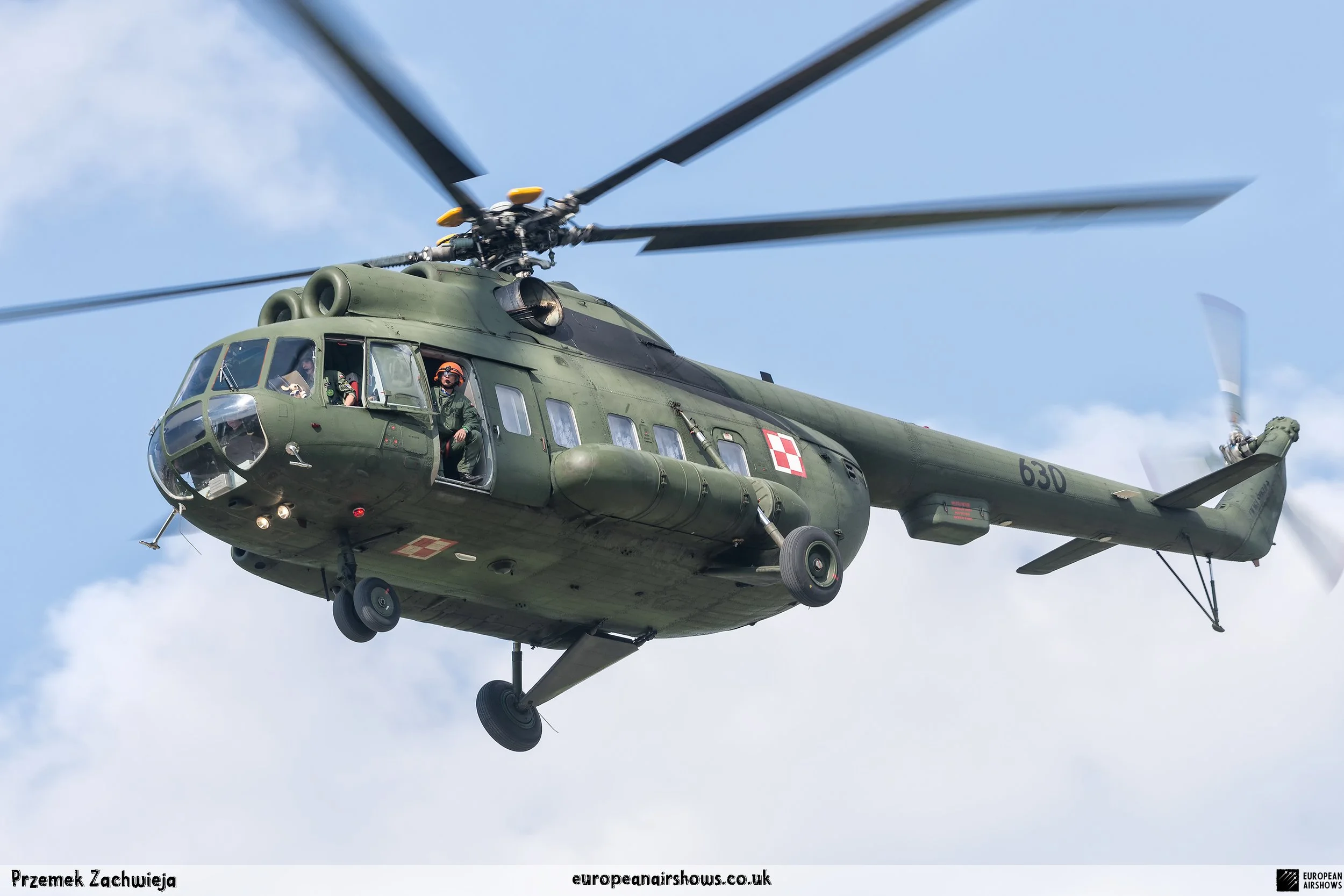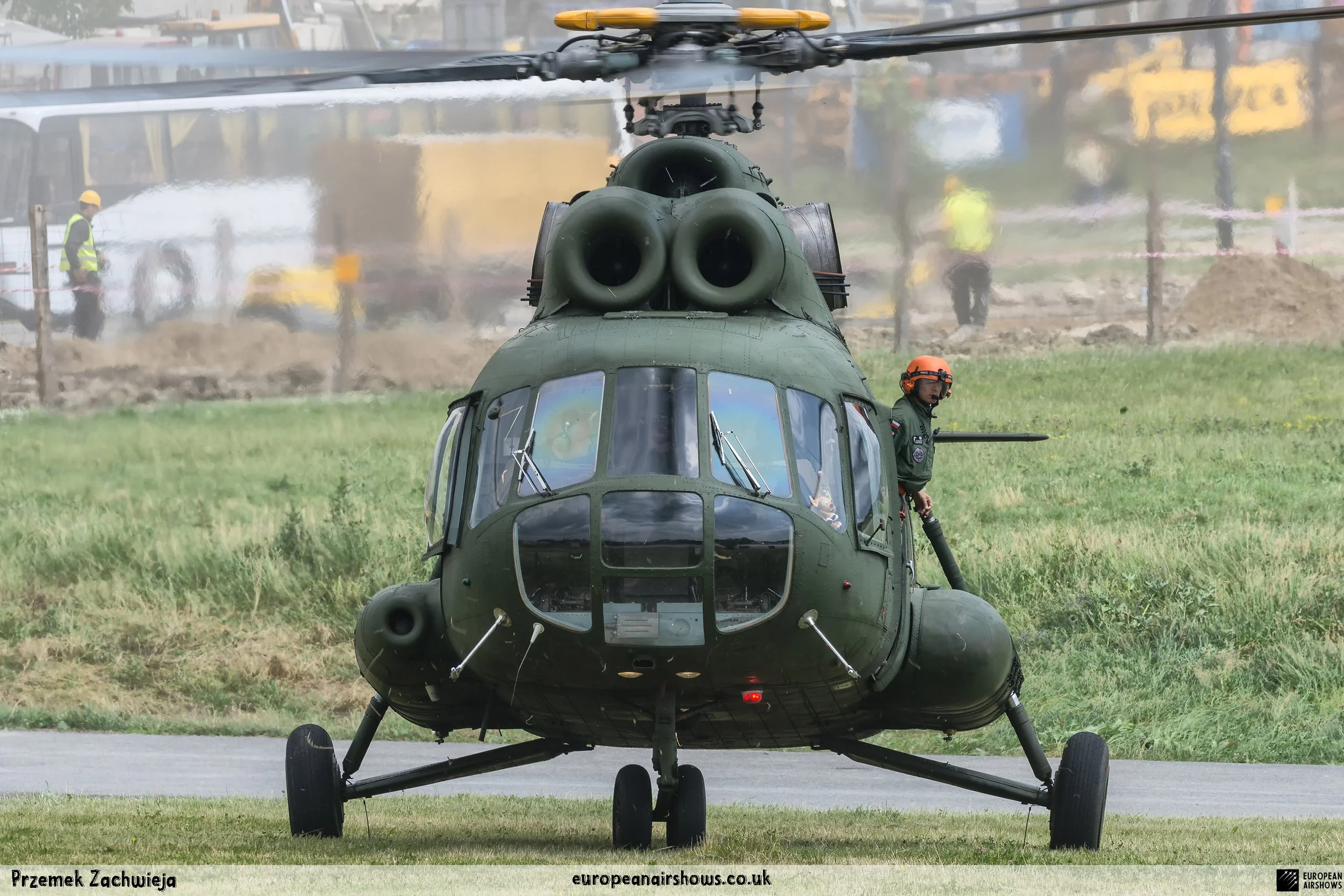
July 7 / Mil Mi-8 first flight
First Flight 7 July 1961
Mil Mi-8 Hip
The Mil Mi-8 (NATO reporting name: Hip) is a medium twin-turbine helicopter, originally designed by the Soviet Union in the 1960s and introduced into the Soviet Air Force in 1968. It is now produced by Russia. In addition to its most common role as a transport helicopter, the Mi-8 is also used as an airborne command post, armed gunship, and reconnaissance platform.
Along with the related, more powerful Mil Mi-17, the Mi-8 is among the world's most-produced helicopters, used by over 50 countries. As of 2015, when combined the two helicopters are the third most common operational military aircraft in the world.
Mikhail Mil originally approached the Soviet government with a proposal to design an all-new two-engined turbine helicopter in 1959 after the success of the Mil Mi-4 and the emergence and effectiveness of turbines used in the Mil Mi-6. After design and development, the Mi-8 was subsequently introduced into the Soviet Air Force in 1967.
The Soviet military originally argued against a new helicopter, as they were content with the current Mil Mi-4. To counter this, Mikhail Mil proposed that the new helicopter was more of an update to new turbine engines rather than an entirely new helicopter, which persuaded the council of ministers to proceed with production. The position of the engine enabled Mikhail Mil to justify redesigning the entire front half of the aircraft around the single-engine.
The prototype, which was named V-8, was designed in 1958 and based on the Mil Mi-4 with a larger cabin. Powered by an AI-24 2,010 kW (2,700 shp) Soloviev turboshaft engine, the single-engined V-8 prototype had its maiden flight in June 1961 and was first shown on the Soviet Aviation Day parade (Tushino Air Parade) in July 1961.
During an official visit to the United States in September 1959, Nikita Khrushchev took a flight in the S-58 presidential helicopter for the first time and was reportedly extremely impressed. On Khrushchev's return, he ordered the creation of a similar helicopter, which was to be ready for the return visit by the American president, to save face. A luxury version of the Mi-4 was quickly created and Khrushchev took an inspection flight, during which Mikhail Mil proposed that his helicopter in development was more suitable. However, it would be necessary to have a second engine for reliability.
This gave Mikhail Mil the power under the orders of Khrushchev to build the original two-engined helicopter, which for the first time in Soviet history would need purpose-built turbine engines, rather than those adapted from fixed-wing aircraft (as in the Mil Mi-6 and the first prototype V-8) and an entirely new main rotor gearbox that would be designed in-house for the first time. In May 1960, the order was given for Mikhail Mil to create his twin-engine helicopter. The Sergei Isotov Design Bureau accepted the task of creating the engines.
The second prototype (still equipped with the one-turbine engine as the Isotov engines were still under development) flew in September 1961.
Two months after the engines were completed by Isotov, the third prototype designated V-8A equipped with two 1,120 kW (1,500 shp) Isotov TV2 engines, made its first flight piloted by Nikolai Ilyushin on 2 August 1962, marking the first flight of any Soviet helicopter to fly with purpose-built gas turbine engines. The aircraft completed its factory-based testing in February 1963.
The fourth prototype was designed as a VIP transport, with the rotor changed from four blades to five blades in 1963 to reduce vibration, the cockpit doors replaced by blister perspex slides and a sliding door added to the cabin.
The fifth and final prototype was a mass-production prototype for the passenger market. In November 1964, all joint testing had been completed and the Soviet government began mass production. Production started in the Kazan Production Plant, with the first aircraft completed by the end of 1965.
The Soviet military originally showed little interest in the Mi-8 until the Bell UH-1's involvement in the Vietnam War became widely publicised as a great asset to the United States, allowing troops to move swiftly in and out of a battlefield and throughout the country. It was only then that the Soviet military rushed a troop-carrying variant of the Mil Mi-8 into production. By 1967, it had been introduced into the Soviet Air Force as the Mi-8.
There are numerous variants, including the Mi-8T, which, in addition to carrying 24 troops, is armed with rockets and anti-tank-guided missiles. The Mil Mi-17 export version is employed by around 20 countries; its equivalent in Russian service in the Mi-8M series. The only visible differences between the Mi-8 and Mi-17 are A) the position of the tail rotor (Mi-8 right side, Mi-17 left side), B) the shape of the exhausts (Mi-8 circular, Mi-17 oval), and C) Dust shields in front of engine air intakes for the Mi-17. Also, the Mi-17 has some improved armour plating for its crew. The naval Mil Mi-14 version is also derived from the Mi-8.
The Mi-8 is constantly improving and the newest version still remains in production in 2016. However, the second generation of the Mi-8 was changed to a tractor-tail rotor configuration as this configuration has increased yaw authority from the upwards advancing tail rotor blades into the downwash. The increase of the airspeed flowing over the rotor blades increases overall tail rotor effectiveness and yaw authority, whereas with the 'Pusher' tail rotor configuration, the advancing rotor blade moves downwards. This decreases the airspeed across the rotor blade, reducing its overall effective yaw authority.
Mil Mi-8 Facts
Widespread Use: The Mil Mi-8, also known by its NATO reporting name “Hip,” is one of the most widely produced helicopters in the world. Over 17,000 units have been built since its introduction in the 1960s, serving in more than 50 countries.
Multi-role Capability: The Mi-8 is a true multi-role helicopter, capable of performing a wide range of missions. These include troop transport, medical evacuation, cargo transport, search and rescue, and even armed assault missions.
First Flight: The Mi-8 made its maiden flight on July 7, 1961. It was designed by the Mil Moscow Helicopter Plant, led by the renowned Soviet aerospace engineer Mikhail Mil.
Variants: There are numerous variants of the Mi-8, each tailored for specific roles. Some of the most notable variants include the Mi-8T (transport), Mi-8MT (armed assault and transport), Mi-8P (passenger transport), and Mi-8AMTSh (modernized assault and transport).
Engine Configuration: The Mi-8 is powered by two turboshaft engines, typically the Klimov TV3-117, which provide the helicopter with a high level of reliability and power. This twin-engine configuration enhances its safety and performance.
Operational Range: The Mi-8 has an impressive operational range, capable of flying up to 610 kilometres (approximately 379 miles) without refuelling. This range can be extended with auxiliary fuel tanks.
High Payload Capacity: One of the Mi-8’s standout features is its high payload capacity. It can carry up to 4,000 kilograms (approximately 8,818 pounds) of cargo internally or externally. This makes it highly effective for logistics and supply missions.
Combat Proven: The Mi-8 has seen extensive combat use in various conflicts around the world, including the Soviet-Afghan War, the Chechen Wars, and numerous peacekeeping and humanitarian missions. Its rugged design and versatility have made it a reliable asset in challenging conditions.
Civilian Applications: In addition to its military roles, the Mi-8 is widely used in civilian applications. It is employed for tasks such as firefighting, oil and gas exploration, VIP transport, and disaster relief, showcasing its adaptability across different sectors.
Modernization Programs: The Mi-8 has undergone several modernization programs to enhance its capabilities and extend its service life. The Mi-17, an export version of the Mi-8, features upgraded avionics, more powerful engines, and improved performance, ensuring that the helicopter remains relevant in modern operations.













